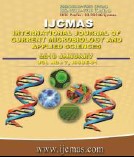


 National Academy of Agricultural Sciences (NAAS)
National Academy of Agricultural Sciences (NAAS)

|
PRINT ISSN : 2319-7692
Online ISSN : 2319-7706 Issues : 12 per year Publisher : Excellent Publishers Email : editorijcmas@gmail.com / submit@ijcmas.com Editor-in-chief: Dr.M.Prakash Index Copernicus ICV 2018: 95.39 NAAS RATING 2020: 5.38 |
Jamun (Syzygium cumini Skeels.) is an important minor indigenous fruit of India belonging to the family Myrtaceae. Jamun cultivation is constrained with the problem of irregular bearing which leads to considerable loss of their production potential. Paclobutrazol a triazole derivative has been effectively used to induce and manipulate flowering, fruiting and tree vigor in several perennial fruit crops. An investigation was taken up at Regional Horticultural Research and Extension Centre (RHREC), University of Horticultural Sciences Campus, Gandhi Krishi Vignana Kendra, Bengaluru, during 2016-17 to exploit the possibility of regularizing the flowering using paclobutrazol (PBZ). The six year old grafted plants of jamun cv Chintamani were applied with 0.5, 1.0, 1.5, 2.0, 2.5 and 3.0 g a.i of PBZ per plant through soil. The control plants did not receive PBZ treatment. The application of PBZ at 3.0 g a.i./ plant resulted less increment in plant height (23.67cm) and canopy spread in N-S (38.50 cm) and E-W (50.83 cm) direction, 2.5 g a.i/ plant resulted in highest number (424) of panicles per plant, number of flowers per panicle (51.33) and length of flowering panicle (16.16 cm). The study revealed that PBZ at 1.5 g a.i/ plant resulted in highest number (292) of new flushes per plant which ultimately led to highest fruit number (4217) and fruit yield per plant (47.13 kg).
 |
 |
 |
 |
 |